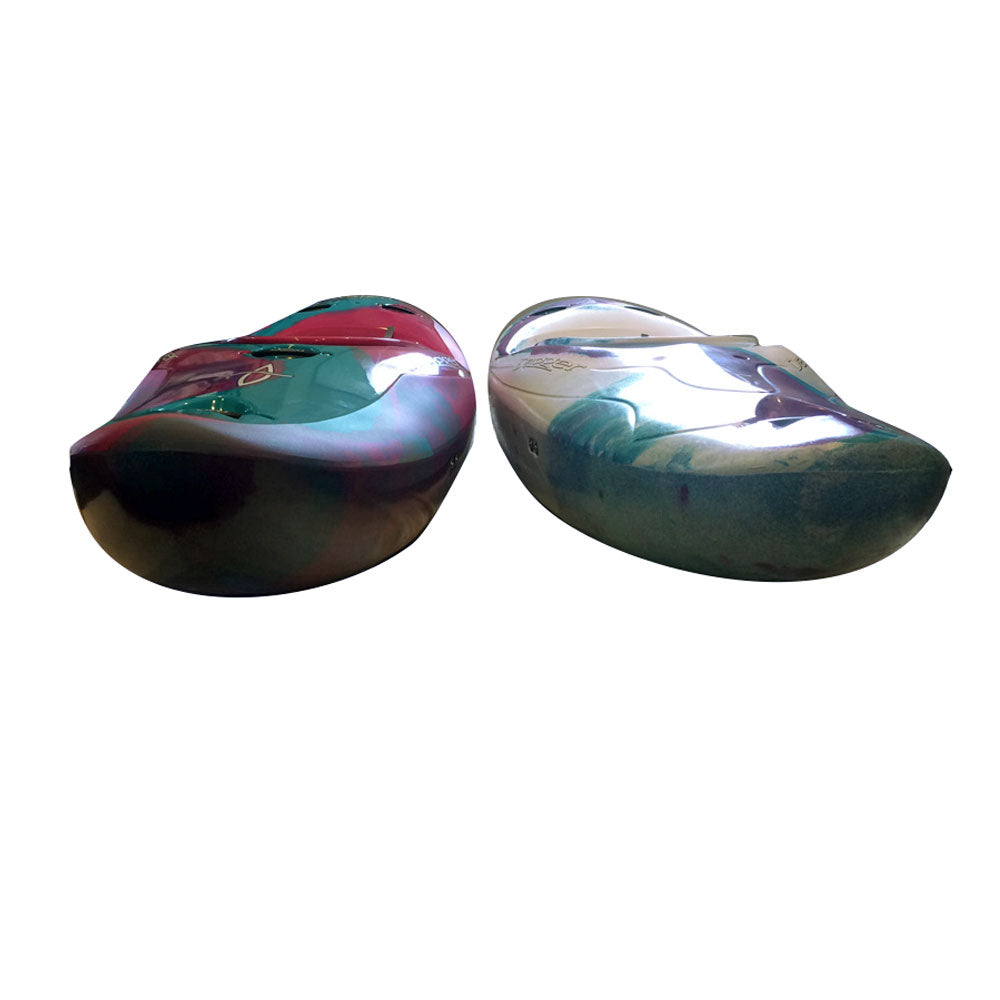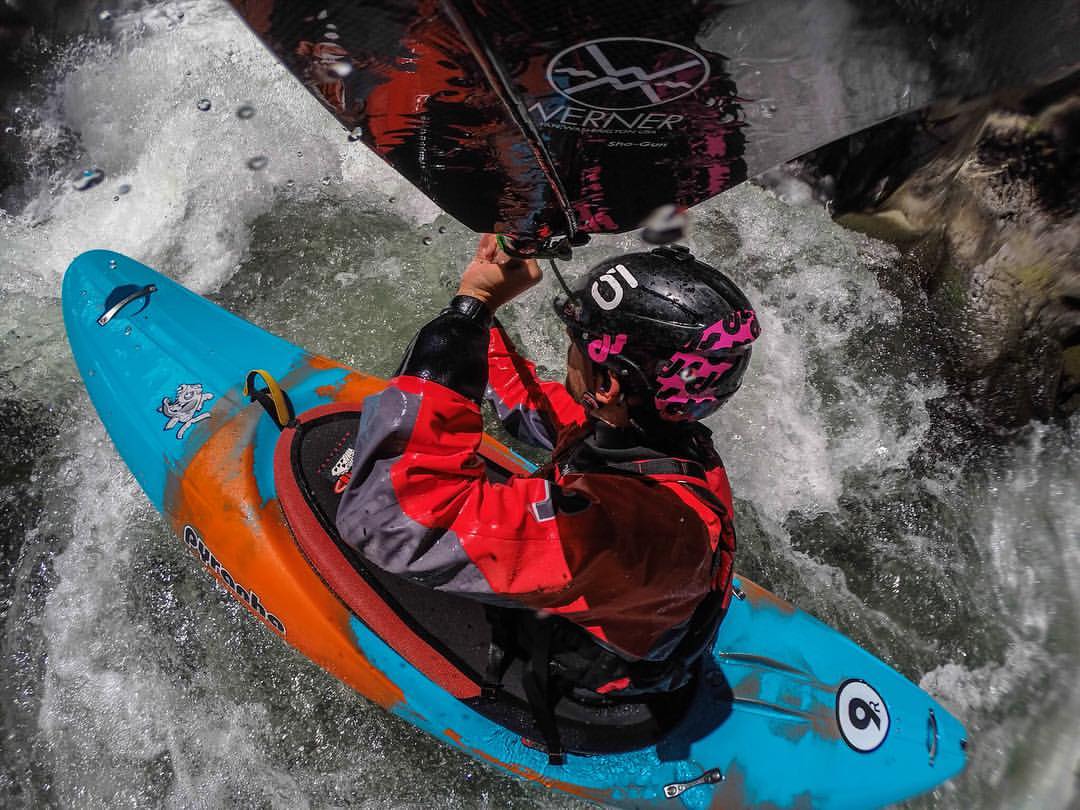The
Dagger Nomad has long been one of the top creek boats on the market. First introduced in the early 2000's, the Nomad was revolutionary. From expeditions to big water to creeking to waterfalls, the Nomad could do it and do it well. Over the years, the boat developed a sort of cult following and for good reason. The original Nomad was stable, forgiving, predictable and would boof anything thrown its way. However, after nearly 12 years, Dagger decided that it was time for a change. At this point, the real question was how to improve on such a successful and well regarded design.
Dagger's answer was the
2016 Nomad, dubbed the "Newmad" by some.
 Fred Morrison in the 2016 Dagger Nomad Large. Photo by Nelson Jones
Fred Morrison in the 2016 Dagger Nomad Large. Photo by Nelson Jones
The first major difference in the
2016 Dagger Nomad is the addition of a "Large" model. Previously, the Nomad was available in two sizes, the 8.1 and 8.5. By today's standards, the larger of the two models, the 8.5, was much smaller than a typical large at a mere 78 gallons. The 2016 Large Nomad comes in at a whopping 96 gallons, perfect for bigger paddlers. The Medium size is 86 gallons, while the new Small model will be 76 gallons, nearly the same volume of the previous generation 8.5.
 2016 Nomad M versus the previous generation Nomad 8.5
2016 Nomad M versus the previous generation Nomad 8.5
Though the boats share the same name, there are many other differences in design, as slight as they may be. Immediately noticeable is the difference in rocker profile. The old Nomad had a fairly continuous rocker profile, meaning that the bow and stern had similar amounts of rocker. This helped with boofing, stability, and tracking. The 2016 Nomad has a progressive rocker profile. What this means is that the rocker was increased in the bow and flattened out in the stern.
On the water, this means that the boat is easier and carries its speed much better than the previous generation.

 It's easy to see the additional rocker in the Newmad.
It's easy to see the additional rocker in the Newmad.

Typically, when rocker is increased, speed and tracking suffer. This is not the case with the 2016 Nomad. The rocker is accentuated at the tip of the bow and stern, which keeps the waterline of the 2016 Nomad longer than its predecessor.
More rocker, more speed, better tracking. What more could one ask for?

The edge (or lack thereof) is another point of difference between the two boats. The original Nomad had a very round hull, with almost no visible edge. The round hull would bounce off of any rock in a predictable and forgiving manner, however in big water, the boat would tend to get pushed around and struggle to hold a line while ferrying.
Not wanting to stray from the predictable, forgiving and stable nature of the original design, the 2016 Nomad remains a full on displacement hull, however, it now has slightly more edge.
The boat is much more responsive when it comes to ferrying, eddy catching and carving. In big water, the
2016 Nomad is still a bit of a pig, especially compared to a designated river runner, such as the Dagger Mamba, Dagger Axiom, Jackson Zen, Pyranha Burn or 9R. It struggles to make tough ferries in big, pushy water, but will stay on-line, punch holes, and boof everything, as expected.
Though the Nomad is not ideal for big water, I would not hesitate to paddle it on a high volume class V run. The stability and forgiveness the boat offers is hard to beat and is a great confidence booster.
 Though it is hard to see, the 2016 Nomad has a much more defined edge, making the Newmad more responsive.
Though it is hard to see, the 2016 Nomad has a much more defined edge, making the Newmad more responsive.

The
2016 Nomad saw an increase in volume across the board, much to the delight of creekboaters everywhere. The increased volume helps power the boat through hydraulics and allows for more storage space for self-support trips. The
2016 Dagger Nomad is a bit narrower than the previous generation, so most of the extra volume lies in the bow and the stern. Some of the extra volume comes from the increased height in front of the cockpit. The new, higher knee position gives paddlers more leverage, making the boat easier to put on edge, therefore more responsive.
The final main difference in the boat is in the outfitting. To save on weight, Dagger removed the seat tray in the 2016 Contour Outfitting. The center pillar in the
2016 Nomad is now anchored into the boat via screws.
Pros:
- Boofs amazingly well
- Stable, predictable, forgiving (what paddlers have come to expect from the Nomad)
- Faster
- More responsive
- Comfortable
- More grab handles than the previous generation
Cons:
- Heavy
- Easily pushed around in big water
All in all, the
2016 Dagger Nomad is a huge improvement on the previous generation. Without straying from what made the original Nomad great, Dagger was able to improve on a very successful design. The increase in volume and length give creek boaters the speed and capacity needed for paddling of all types, while the tweaks to the rocker and edge of the boat made it more responsive than ever. I have been paddling the boat for a few weeks now and have been nothing but impressed. Oh Be Joyful season is just around the corner and I can't wait to get this boat on it.
 Entering Tunnel Falls on Gore Canyon in the 2016 Nomad Medium. Photo by Nelson Jones
Entering Tunnel Falls on Gore Canyon in the 2016 Nomad Medium. Photo by Nelson Jones
 Fred Morrison in the 2016 Dagger Nomad Large. Photo by Nelson Jones
Fred Morrison in the 2016 Dagger Nomad Large. Photo by Nelson Jones
 2016 Nomad M versus the previous generation Nomad 8.5
2016 Nomad M versus the previous generation Nomad 8.5

 It's easy to see the additional rocker in the Newmad.
It's easy to see the additional rocker in the Newmad.
 Typically, when rocker is increased, speed and tracking suffer. This is not the case with the 2016 Nomad. The rocker is accentuated at the tip of the bow and stern, which keeps the waterline of the 2016 Nomad longer than its predecessor. More rocker, more speed, better tracking. What more could one ask for?
Typically, when rocker is increased, speed and tracking suffer. This is not the case with the 2016 Nomad. The rocker is accentuated at the tip of the bow and stern, which keeps the waterline of the 2016 Nomad longer than its predecessor. More rocker, more speed, better tracking. What more could one ask for?
 The edge (or lack thereof) is another point of difference between the two boats. The original Nomad had a very round hull, with almost no visible edge. The round hull would bounce off of any rock in a predictable and forgiving manner, however in big water, the boat would tend to get pushed around and struggle to hold a line while ferrying. Not wanting to stray from the predictable, forgiving and stable nature of the original design, the 2016 Nomad remains a full on displacement hull, however, it now has slightly more edge. The boat is much more responsive when it comes to ferrying, eddy catching and carving. In big water, the 2016 Nomad is still a bit of a pig, especially compared to a designated river runner, such as the Dagger Mamba, Dagger Axiom, Jackson Zen, Pyranha Burn or 9R. It struggles to make tough ferries in big, pushy water, but will stay on-line, punch holes, and boof everything, as expected. Though the Nomad is not ideal for big water, I would not hesitate to paddle it on a high volume class V run. The stability and forgiveness the boat offers is hard to beat and is a great confidence booster.
The edge (or lack thereof) is another point of difference between the two boats. The original Nomad had a very round hull, with almost no visible edge. The round hull would bounce off of any rock in a predictable and forgiving manner, however in big water, the boat would tend to get pushed around and struggle to hold a line while ferrying. Not wanting to stray from the predictable, forgiving and stable nature of the original design, the 2016 Nomad remains a full on displacement hull, however, it now has slightly more edge. The boat is much more responsive when it comes to ferrying, eddy catching and carving. In big water, the 2016 Nomad is still a bit of a pig, especially compared to a designated river runner, such as the Dagger Mamba, Dagger Axiom, Jackson Zen, Pyranha Burn or 9R. It struggles to make tough ferries in big, pushy water, but will stay on-line, punch holes, and boof everything, as expected. Though the Nomad is not ideal for big water, I would not hesitate to paddle it on a high volume class V run. The stability and forgiveness the boat offers is hard to beat and is a great confidence booster.
 Though it is hard to see, the 2016 Nomad has a much more defined edge, making the Newmad more responsive.
Though it is hard to see, the 2016 Nomad has a much more defined edge, making the Newmad more responsive.
 The 2016 Nomad saw an increase in volume across the board, much to the delight of creekboaters everywhere. The increased volume helps power the boat through hydraulics and allows for more storage space for self-support trips. The 2016 Dagger Nomad is a bit narrower than the previous generation, so most of the extra volume lies in the bow and the stern. Some of the extra volume comes from the increased height in front of the cockpit. The new, higher knee position gives paddlers more leverage, making the boat easier to put on edge, therefore more responsive.
The final main difference in the boat is in the outfitting. To save on weight, Dagger removed the seat tray in the 2016 Contour Outfitting. The center pillar in the 2016 Nomad is now anchored into the boat via screws.
Pros:
The 2016 Nomad saw an increase in volume across the board, much to the delight of creekboaters everywhere. The increased volume helps power the boat through hydraulics and allows for more storage space for self-support trips. The 2016 Dagger Nomad is a bit narrower than the previous generation, so most of the extra volume lies in the bow and the stern. Some of the extra volume comes from the increased height in front of the cockpit. The new, higher knee position gives paddlers more leverage, making the boat easier to put on edge, therefore more responsive.
The final main difference in the boat is in the outfitting. To save on weight, Dagger removed the seat tray in the 2016 Contour Outfitting. The center pillar in the 2016 Nomad is now anchored into the boat via screws.
Pros:
 Entering Tunnel Falls on Gore Canyon in the 2016 Nomad Medium. Photo by Nelson Jones
Entering Tunnel Falls on Gore Canyon in the 2016 Nomad Medium. Photo by Nelson Jones




